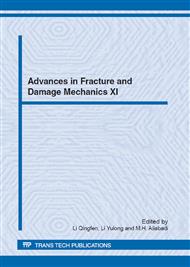p.157
p.161
p.165
p.169
p.173
p.177
p.181
p.185
p.189
Load Influence on the Behavior of Micro-Crack in the Particulate Composite
Abstract:
Particulate composite with soft polymer matrix and rigid mineral fillers are one of most frequently used construction and engineering materials. The main focus of a present paper is an estimation of the load influence on behavior of micro-crack placed in close proximity to the particle with interphase in soft matrix. The particulate composite with polymer matrix filled by magnesium-based mineral fillers is investigated by means of the finite element method. A non-linear material behavior of the matrix was considered. Numerical model on the base of representative plane element (RPE) was developed. The conclusions of this paper can contribute to a better understanding of the behavior of micro-crack in particulate composites with soft polymer matrix.
Info:
Periodical:
Pages:
173-176
Citation:
Online since:
November 2012
Authors:
Price:
Сopyright:
© 2013 Trans Tech Publications Ltd. All Rights Reserved
Share:
Citation:


